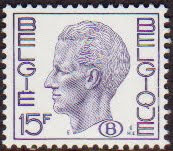Baudouin I of Belgium Biography
King Baudouin, (also spelled Boudewijn, Balduin or Baldwin) Albert Charles Leopold Axel Marie Gustave, (7 September 1930 - 31 July 1993), reigned as King of the Belgians from 1951 to 1993. He was the elder son of King Leopold III (1901-1983) and his first wife, Princess Astrid of Sweden (1905-1935). Boudewijn is his Dutch name; Balduin in German; Baudouin in French, which is also mostly used in foreign languages, though sometimes in English Baldwin copying Baldwin I of Jerusalem.
Baudouin was born in Kasteel Stuyvenberg, Laeken in Belgium. He became king when his father abdicated on July 16, 1951. Part of Leopold III's unpopularity was the result of an unpopular second marriage in 1941 to Mary Lilian Baels, an English-born Belgian commoner known as Princess de Réthy. More controversial had been his decision to surrender to Nazi Germany at the start of World War II, in 1941; many Belgians still questioned his loyalties, though history indicates that Leopold surrendered in order to spare his country bloodshed and destruction. Though reinstated in a plebiscite after the war, it became clear that Leopold was too controversial a person to be a unifying force, hence the abdication.
On December 15, 1960, Baudouin was married at Brussels to Doña Fabiola Fernanda Maria de las Victorias Antonia Adelaïda Mora y Aragon, a former nurse and a writer of children's stories. Immensely popular for her good cheer, personal modesty, and devotion to social causes, Queen Fabiola was born at Madrid, Spain on June 11, 1928, a daughter of Don Gonzalo Mora Fernandez Riera del Olmo, Marques de Casa Riera, Conde de Mora, and his wife, Doña Blanca de Aragon y Carrillo de Albornoz Barroeta-Aldamar y Elio. The Belgian royal couple had no children.
There was some concern among politicians close to the King that he might actually be in love with his stepmother, Princess Lilian, suspicions fueled by secret recordings of surprisingly intimate-sounding telephone conversations between the two. The post-wedding actions of the king's father and stepmother only increased speculation; they briskly moved out of the royal palace at Laeken and reportedly broke off relations with Baudouin for some time.
During Baudouin's reign the colony of Belgian Congo was given its independence. In 1976, on the 25th anniversary of Baudouin's accession the King Baudouin Foundation was formed, with the aim of improving the living conditions of the Belgian people.
He was a very religious man. In 1990, when a law liberalising Belgium's abortion laws was approved by parliament, he refused to give his signature so that the bill could become law - an unprecedented act in Belgium, as the royal signature has always been considered a mere formality. The government had to declare him unable to reign on April 4, 1990. The Belgian constitution provides that, if the king is incapable to reign, the government as a whole will fulfil the role of head of state. All members of the government signed the bill, and the government declared that Baudouin was capable of reigning again the next day, on April 5, 1990.
He reigned for 42 years until he died of heart failure on July 31, 1993 in the Villa Astrida in Motril, in the south of Spain. He was interred in the royal vault at the Church of Our Lady, Laeken Cemetery, Brussels, Belgium.
Baudouin was succeeded by his younger brother, who became King Albert II.
-
Stamps from King Boudewijn.
--------
-
-
-
--------
----------
---------------
-------------------
------------------------
------------------
---------------------
--------------------
---------------------
---------------------------
2.50 fr green.
---------------------
----------------
6 fr red.
8 fr grey.
30 fr orange.
-

































































































































Geen opmerkingen:
Een reactie posten